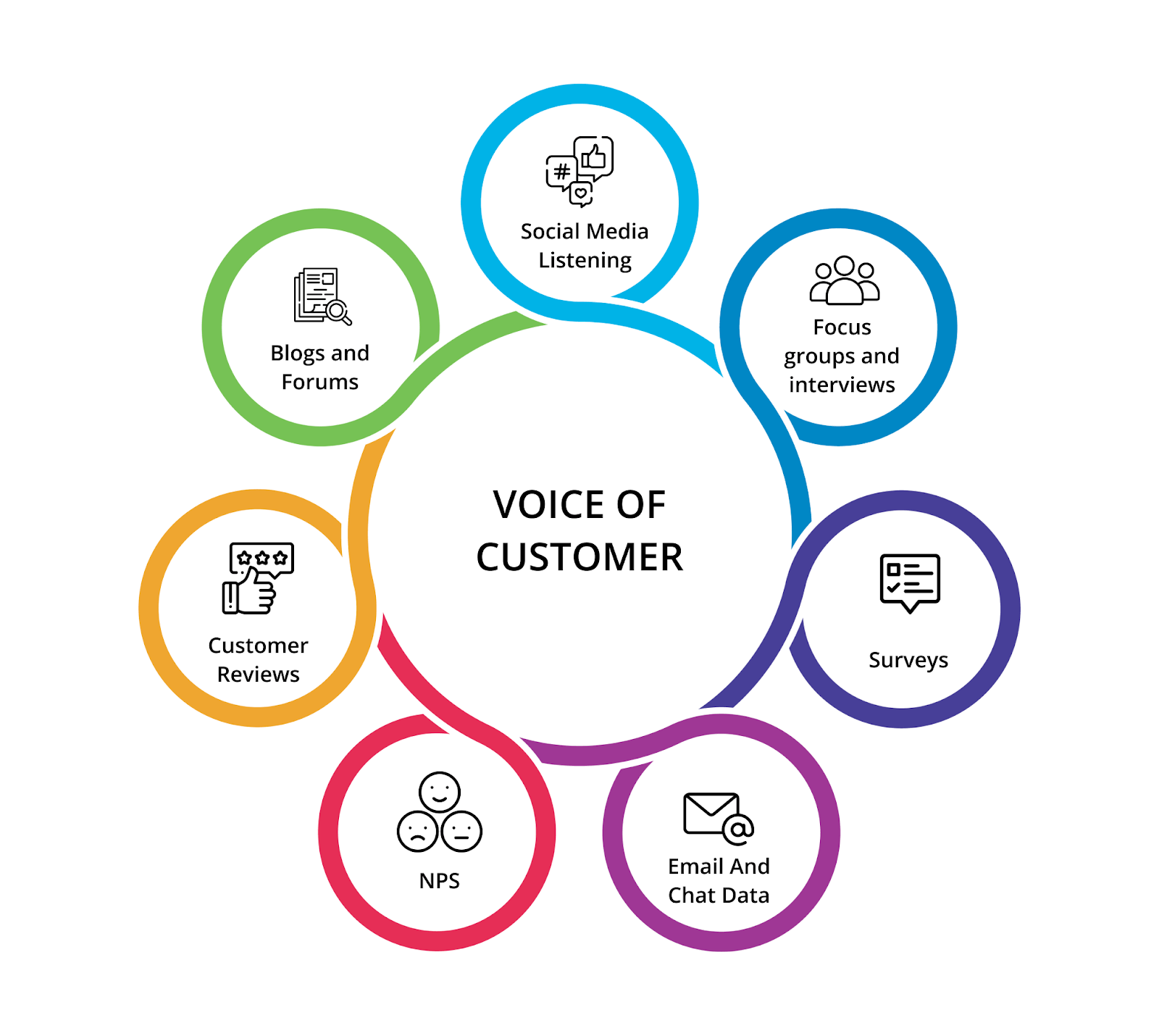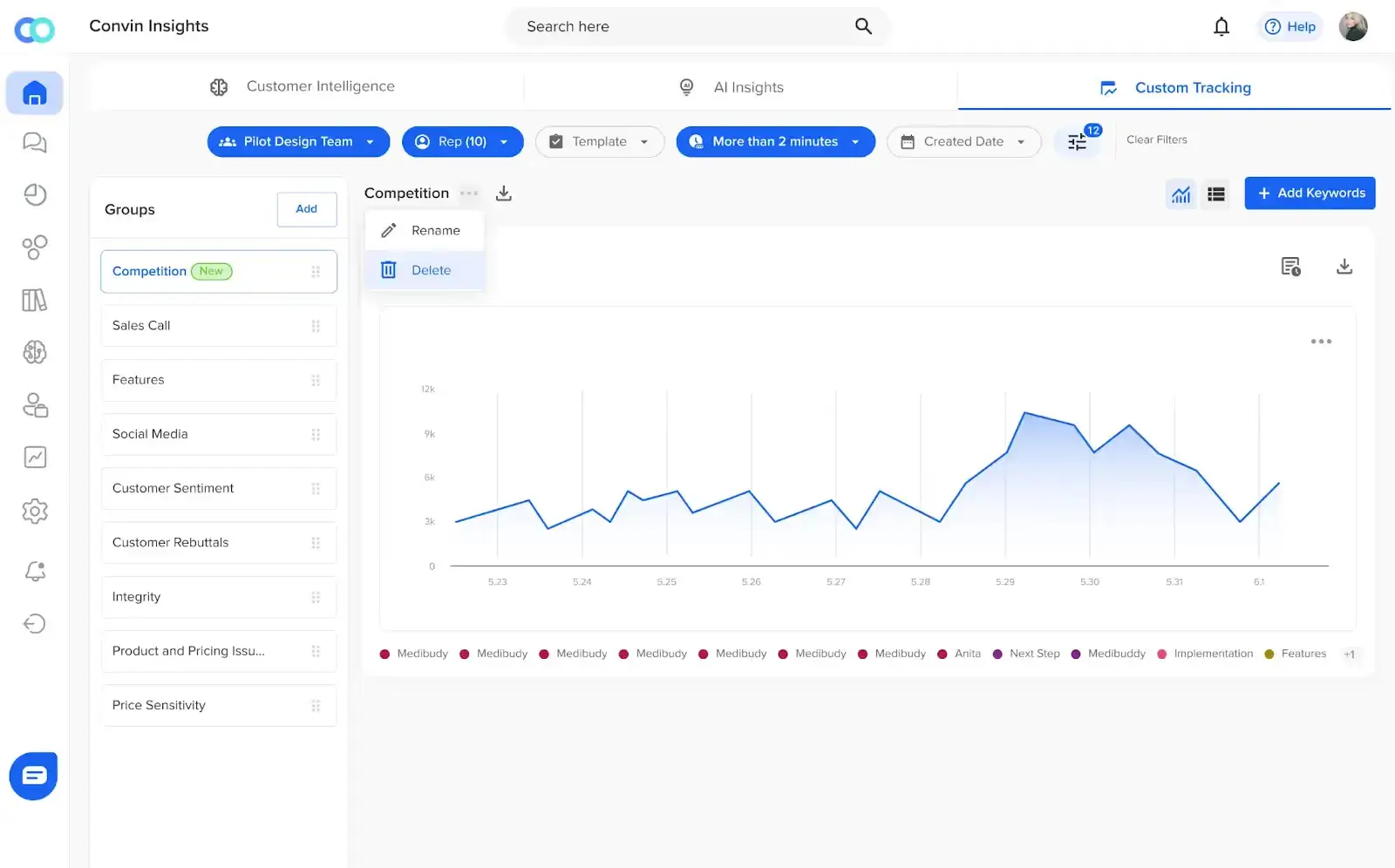In today's AI-driven landscape, collecting feedback isn’t enough. You need voice of customer software that can capture, analyze, and act on insights—instantly.
For call centers, the ability to harness voice of customer software alongside VoC data is critical for enhancing service quality, reducing churn, and building loyalty. Traditional methods lack speed and depth, which is why modern voice of customer tools powered by AI are reshaping the game.
This blog explores how AI-powered tools transform VoC data collection and analysis for call centers.
Go beyond basic feedback with Convin’s voice of customer software.
What is Voice of the Customer (VoC)?
Voice of the Customer (VoC) refers to gathering and understanding customer needs, expectations, and feedback. VoC data offers actionable insights that help companies enhance customer experiences, resolve common issues, and align products with customer demands.
By incorporating VoC in call centers, leaders can bridge the gap between customer expectations and service delivery. Capturing the voice of the customer is crucial to staying competitive and successfully meeting customer needs.

Why Voice of the Customer is Vital for Call Centers
Call centers are on the front lines of customer interactions, making them ideal platforms for VoC data collection. By understanding VoC, call center managers can improve agent training, optimize service delivery, and directly address customer pain points. With AI, call centers can analyze customer feedback and behavior at scale, offering deeper insights and precise, real-time improvements.
For example, through AI-driven VoC insights, companies like Amazon have refined their customer service strategies, creating faster resolution times and more personalized experiences. These improvements boost overall satisfaction and retention.
Key Voice of the Customer (VoC) Stages
Capturing the customer's voice follows a strategic process that includes several stages. Here, we’ll break down these essential stages to understand how they fit into call center operations.
1. VoC Collection
VoC collection involves gathering data from different customer interactions and feedback channels. Call centers can collect this data from phone calls, chats, emails, and social media. In the age of AI, automated tools record and analyze these interactions, allowing call centers to capture comprehensive data on customer preferences and issues.
In this stage, AI-based systems like Convin use natural language processing (NLP) to transcribe and evaluate calls, identifying keywords and customer sentiments. This provides valuable insights into customer pain points and satisfaction levels.
2. VoC Analysis
Once collected, VoC data needs to be analyzed for patterns and actionable insights. AI-powered analysis tools automatically examine customer interactions to detect recurring themes, sentiments, and satisfaction metrics. Convin, for example, performs real-time analysis on conversations, helping managers detect performance issues or escalations.
Analyzing VoC data helps call centers make data-driven decisions, leading to better service and customer experience.
3. VoC Reporting and Action
In the final stage, insights from VoC analysis are shared with relevant teams, helping them act on the feedback and improve. For instance, if data reveals customers frequently complain about long wait times, call center leaders can adjust staffing or training efforts.
AI systems make reporting easier through automated dashboards and real-time alerts, ensuring managers and agents can quickly act on VoC insights.
Mastering each stage of the Voice of the Customer process—from collection to reporting—is crucial for transforming raw customer feedback into meaningful actions. By following these stages, call centers can better understand customer needs and proactively address issues, ultimately driving stronger customer relationships and long-term loyalty.
Benefits of AI-Driven Voice of the Customer for Call Centers
Using AI-driven VoC tools in call centers provides numerous benefits, from improved efficiency to enhanced customer satisfaction. Here are some of the key advantages:
- Enhanced Customer Insights: AI tools allow call centers to extract detailed insights on customer needs, helping managers make strategic adjustments.
- Personalized Customer Experiences: Real-time feedback enables agents to tailor interactions, creating a more personalized customer experience.
- Increased Agent Productivity: AI-guided tools streamline agents’ tasks, reducing time spent on manual data entry and follow-ups.
Overall, AI-driven VoC solutions empower call centers to make data-informed decisions that directly enhance customer satisfaction and loyalty.
This blog is just the start.
Unlock the power of Convin’s AI with a live demo.

AI-Powered Voice of Customer Software for Call Centers
Voice of the customer tools powered by AI enable call centers to transform data collection and analysis. Here are some cutting-edge tools designed to capture and leverage VoC effectively.
1. Speech Analytics Software
AI-driven speech analytics software allows call centers to analyze voice data in real-time. Through machine learning algorithms, this tool categorizes emotions, identifies critical keywords, and flags potential issues.
For instance, Convin’s speech analytics platform captures 100% of customer interactions and converts them into structured data, helping managers instantly understand customer behavior trends and agent performance.
2. Survey Tools Integrated with AI
Surveys are a traditional method for capturing VoC data, but AI-powered survey tools can analyze open-ended responses and sort them by sentiment, urgency, and topic. Tools like Qualtrics and Medallia integrate AI into surveys to help call centers interpret customers' nuanced language, providing insights on satisfaction and areas for improvement.
These advanced survey tools allow continuous feedback collection, keeping call centers updated on customer perceptions and needs.
3. Sentiment Analysis Software
Sentiment analysis software examines customer interactions to assess their emotions and tone. This tool can analyze calls, chat, and email transcripts, offering insights into customer satisfaction. Call centers can prioritize escalated cases and provide personalized support by understanding sentiment trends.
4. Real-Time Agent Assist
Real-time agent assist software uses AI to offer agents helpful prompts and information while interacting with customers. Convin’s real-time agent assist provides agents with instant guidance based on the customer's words and tone, helping agents resolve issues efficiently and avoid critical mistakes.
These real-time tools ensure that agents have the right information at the right time, significantly improving customer interactions and outcomes
Want to know what your customers truly think?
Voice of Customer Examples: Real-World Applications
Understanding the voice of customer examples can help call centers visualize how VoC tools work in real-world settings.
Example 1: Reducing Customer Churn
A telecom company used VoC analysis to identify common customer complaints about billing issues and poor support response times. Using sentiment analysis tools, they pinpointed dissatisfied customers and initiated retention offers, reducing churn by 20%.
Example 2: Improving Agent Training
A retail company integrated speech analytics and agent assist tools to analyze VoC data, highlighting gaps in agent knowledge. Based on these findings, they tailored agent training programs to address frequent customer issues, enhancing first-call resolution rates by 15%.
These examples illustrate how call centers can proactively use VoC tools to address issues, leading to better customer experiences and loyalty.
Convin and AI Insights: Transforming Voice of Customer (VoC) in Call Centers
Convin Insights offers call centers a robust tool for understanding the voice of the customer through real-time conversation analysis. Here’s how Convin and AI-driven insights elevate VoC strategies:
- Comprehensive Data Collection: Convin captures every customer interaction, analyzing calls, chats, and emails to provide a 360-degree view of customer sentiment and preferences.
- In-Depth Performance Tracking: By identifying key trends in customer feedback, Convin reveals where agents excel and where improvement is needed, enabling targeted coaching.

Convin’s AI Insights add another layer by detecting patterns across vast volumes of VoC data:
- Sentiment and Emotion Analysis: AI algorithms pinpoint emotions and attitudes in customer responses, helping managers prioritize issues and enhance customer satisfaction.
- Actionable Reporting: AI-driven insights transform raw data into actionable steps, enabling managers to implement improvements directly impacting customer loyalty.
By combining Convin and AI insights, call centers can create a proactive, data-driven VoC strategy that enhances agent performance and customer experience.
Discover how AI can enhance your VoC strategy
Adapting the Voice of Customer Software in the Age of AI
The voice of the customer is essential for delivering superior customer experiences, and with AI, collecting and analyzing VoC data has become more accurate and efficient. By implementing AI-driven VoC tools, call centers can stay competitive, reduce churn, and elevate the customer journey.
As tools like Convin demonstrate, AI enables deeper insights and immediate action, positioning call centers for success in an increasingly customer-focused market.
Embracing VoC technology empowers call centers to listen to customers and effectively respond to their needs.
Take action now. See how Convin’s voice of customer software helps turn feedback into results—book a demo today.
Unlock real insights with AI-powered voice of customer software.
Frequently Asked Questions
1. What are some common Voice of the Customer (VoC) metrics?
Common VoC metrics include Net Promoter Score (NPS), Customer Satisfaction (CSAT), Customer Effort Score (CES), and Customer Retention Rate, which help measure customer loyalty, satisfaction, and ease of interaction.
2. How does AI improve customer feedback analysis in call centers?
AI automates the analysis of vast amounts of feedback, identifying trends, sentiments, and key issues faster and more accurately than manual methods. This enables quicker responses to customer needs.
3. What’s the difference between Voice of the Customer (VoC) and Customer Experience (CX)?
VoC focuses on gathering and analyzing direct customer feedback. At the same time, CX is the overall perception of the customer’s journey, influenced by VoC insights and service quality, brand perception, and user experience.
4. How can VoC data be used beyond call centers?
VoC data benefits multiple departments, such as product development (to improve offerings), marketing (to refine messaging), and sales (to address customer pain points), creating a more aligned, customer-focused organization.









.avif)